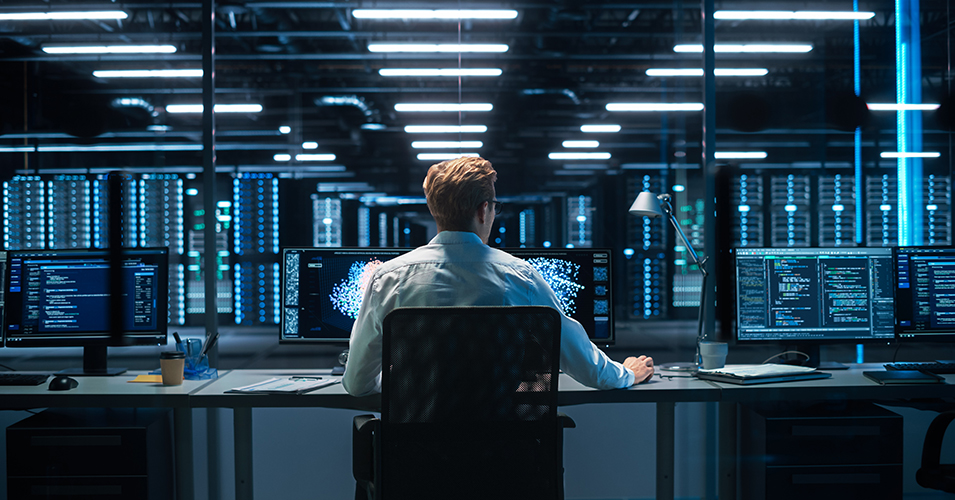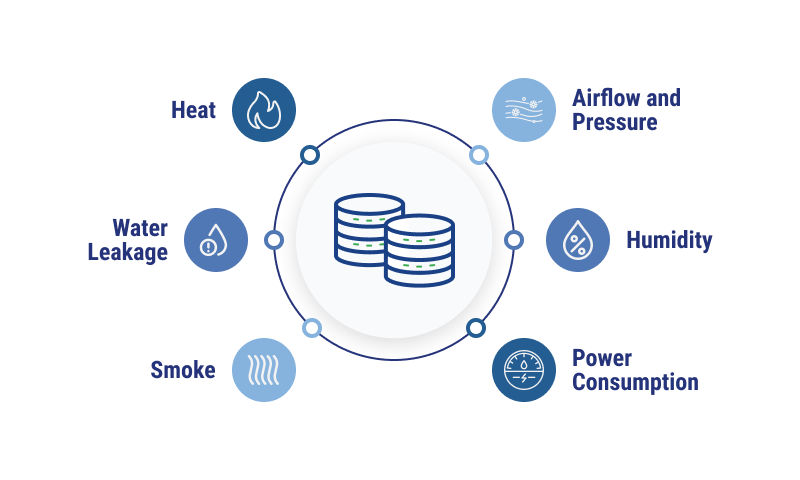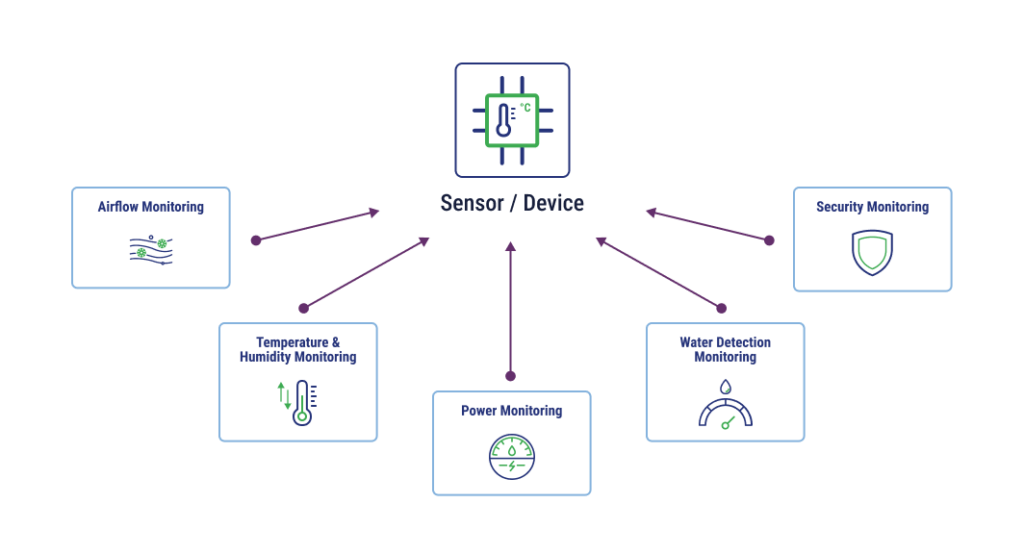December 13, 2023 | Channing Lovett
Optimize Efficiency with Data Center Environmental Monitoring

Being aware of your surroundings can help keep you attuned to potential risks and threats around you, and the same goes for data center environments. When data centers understand what’s happening at their facilities 24/7 and have monitoring in place to detect environmental issues or anomalies, they have the ability to stop problems in their tracks before they balloon into something more disastrous.
We’ll talk about what’s included in environmental monitoring, how data centers can monitor different environmental conditions, and the benefits that can come with proper monitoring.
What is Data Center Environmental Monitoring?
Data center environmental monitoring is the practice of collecting and examining data about the physical aspects of a data center environment. These environmental aspects include temperature, humidity, power consumption, and airflow. The metrics collected during monitoring are used to determine whether the data center is operating under acceptable conditions.
Environmental Risks and Metrics Monitored in Data Centers
It’s important to monitor the environment of the data center. Even minor fluctuations in the long term can lead to degradation or malfunctioning equipment, putting performance and reliability at risk. Data centers should be regularly monitored for temperature, humidity, smoke, power consumption, water leakage, airflow, and pressure.

Heat
Temperature, specifically heat, is a critical metric data centers need to keep monitoring. Data centers should stay between the ideal range of 68- and 72-degrees Fahrenheit to maximize equipment reliability and reduce downtime.
Humidity
To keep equipment safe, humidity levels should remain between about 45-55%.
Smoke
Data centers should install smoke detectors to identify potential fires before they spread.
Power Consumption
A data center can measure how efficiently it uses energy through the power usage effectiveness (PUE) metric. PUE is calculated by taking the total energy consumed by the data center and dividing it by how much is consumed by IT equipment. The lower the PUE, the more efficient the data center.
Water Leakage
Water leaks can damage sensitive equipment and severely impact business continuity. They can also lead to expensive replacements and repairs.
Airflow and Pressure
Data centers that use air cooling also need to monitor airflow to ensure it is properly cooling equipment. This coincides with pressure, which is used to make sure air is flowing properly through the data center.
Essential Components of Data Center Environmental Monitoring
So, how does the process of environmental monitoring in a data center work? Facilities use sensors, sometimes IoT sensors, and other devices to perform monitoring of different environmental factors in a data center.

Temperature and Humidity Monitoring
If the temperature in a data center falls outside of the acceptable range, it can lead to decreased performance or complete equipment shutdowns. Temperature can be measured by a sensor that is similar to a household thermometer that issues alerts when the environment goes beyond set operating limits.
These sensors may also measure both absolute, relative, and ambient humidity. Absolute humidity is a measure of the water vapor present in the air, whereas relative humidity represents how much water vapor can be held in the air based on its current temperature. To avoid condensation, relative humidity needs to stay under 90%. However, air that’s too dry can also cause problems with static discharge, so relative humidity also needs to be above 10%. Ambient humidity is concerned with the humidity level in the surrounding environment, normally measured at the air intake of a data center’s air conditioning system. While individual components may be able to operate between 20-80% relative humidity, ambient humidity should remain around 45-55%. An environment monitoring system (EMS) that includes humidity sensors can notify staff when humidity falls below 40% and above 60%, for example.
Airflow Monitoring
A major component of air quality in data centers is airflow around the equipment. This is the most important metric behind temperature for data centers that rely on air cooling. Monitors that capture airflow need to be able to confirm that the amount of air moving through the equipment is enough to meet the demands of the system.
Water Detection Monitoring
Water detection systems can use a few different types of sensors to detect the presence of water to mitigate larger impacts from leakage.
Conductive rope sensors can trigger an alarm when the rope and accompanying conductive wires come in touch with water. These sensors are normally placed in areas that can identify leaks close to equipment, such as under racks. Other monitors work similarly, including smart cables, leak detection tubes, and spot sensors. Each one uses slightly different technology to sense water quickly.
Power Monitoring
Continuous electrical power is a critical component in preventing downtime, and understanding both frequency stability and delivered voltage is vital.
Monitoring tools should look at the current load and demand (what’s coming into the facility), and how much power each cabinet or rack is consuming. Any deviations in normal consumption or outages, no matter how brief, should be able to be reported in an instant. Power monitoring systems can also be accompanied by generators or uninterrupted power supplies (UPS) that trigger when an outage is detected.
Security Monitoring
Security systems may be thought of in terms of cybersecurity when it comes to data centers, but what about physical security? Cameras, access control badges, perimeter fences, and secure locks can all protect the physical environment from intruders and bad actors.
Benefits of Data Center Environmental Monitoring
So, how exactly does data center environmental monitoring keep your operations running smoothly? By using real-time monitoring and predictive tools powered by artificial intelligence and machine learning (AI/ML), businesses can uncover problems early, decrease costs, and maximize uptime.
Early Detection and Identification of Problems
Detecting problems early, or better yet, identifying incidents before they become bigger problems, can prevent data loss, financial loss, and business disruptions. Some monitoring tools may use artificial intelligence and machine learning (AI/ML) to pinpoint the beginning stages of a problem. Early detection is one of the primary ways data centers can improve uptime.
Improved Uptime
Without continuous power and an eye on other key factors of the data center environment, businesses can experience operational and financial harm from downtime. According to SolarWinds, the average cost of downtime can range anywhere from $427 to $9,000 per minute, depending on the size of your organization. Regular data center monitoring can improve uptime and ensure availability.
Better Energy and Resource Management
Managing energy and resources can both reduce energy costs and improve the sustainability of a data center. Putting the right environmental monitoring tools in place can easily support better energy and resource management at the data center; and they can help find opportunities for preventative fixes that reduce the cost of downtime.
Greater Insights
In data center environments, what you don’t know can hurt you – your productivity, the state of your equipment, and the trust others have in your organization. By gaining greater insights into the operation of the data center, you can find trends and patterns that keep the facility running efficiently.
Decrease Downtime with Efficient Environmental Monitoring
Businesses that choose state-of-the-art data centers don’t need to worry about environmental monitoring. TierPoint’s colocation data centers and high-density colocation data centers, for example, come with several environmental controls and efficiency benefits. Our precise environmental controls minimize temperature variation at the rack level and create efficiencies in operating expenses.
Contact us to learn more about how our environmental controls can help keep your workloads safe and at their best today.

FAQs
Environmental monitoring in a data center can be done by many different types of equipment, including temperature sensors, humidity sensors, security cameras, smoke detectors, water detection systems, and more
A data center environment can be controlled by using HVAC systems, humidifiers, variable frequency drives (VFB), fans, power meters, and air filtration systems, to name a few devices.
